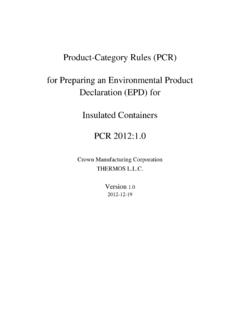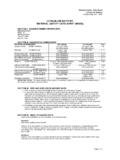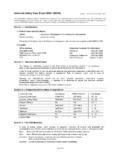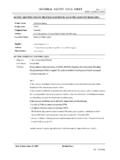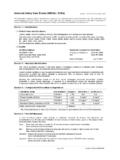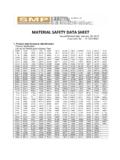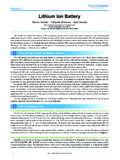Transcription of Product-Category Rules (PCR) for Preparing an ...
1 Product-Category Rules (PCR) for Preparing an environmental product declaration (EPD) for lithium -ion Secondary battery Pack for Consumer Electronics PCR 2014 Taiwan battery Association Gallopwire Enterprise CO., LTD Version 2014-11-30 Table of Contents 1. General Information .. 1 2. Company and product description .. 1 product group function .. 1 product components/compositions .. 2 product technical description .. 3 3. List of materials and chemical substances .. 3 4. Declared unit .. 4 5. System boundaries .. 4 Specification of different boundary settings .. 6 6. Cut-off Rules .. 7 7. Allocation Rules .. 7 8. Units .. 8 9. Calculation Rules and data quality requirements .. 8 10. Parameters to be declared in the EPD .. 9 11. Recycling information.
2 11 12. Other environmental information (Optional) .. 11 13. Information about the certification .. 12 Appendix I Generic Data Sources to Refer to .. 14 Appendix II Reporting Format for the EPD .. 15 Appendix III Abbreviations .. 17 1 1. General Information This document is to be used as the product category Rules (PCR) for the manufacturing of lithium -ion secondary battery pack for consumer electronics ( products ) globally. The requirements specified in this PCR are intended to be used for EPDs certified in accordance with the ISO 14025 standard. This document shall be valid until December 31, 2016. This PCR was first drafted by the Taiwan battery Association(TBA) and Gallopwire Enterprise CO., LT D(GLW). Representatives from major Taiwanese manufacturers of similar products and stakeholders were then invited by the Taiwan Electrical and Electronic Manufacturers Association(TEEMA) to the open consultation meeting held on November 25, 2014, to participate in the discussion and review of this PCR.
3 The Environment and Development Foundation (EDF) subsequently reviewed and approved this PCR. For further information and comments concerning this PCR, please contact: Taiwan battery Association Secretariat, Miss Bella Peng(Tel:+886-3-5918474 Fax:+886-3-5820262 Gallopwire Enterprise CO., LTD, William Wu (Tel:+886-2-2785-6098#1110 Fax:+886-2-2785-6355 2. Company and product description The EPD shall include information about the manufacturing company/organization. The information may include manufacturing process related information, and environmental related information, such as the environmental management system information. The information may also include special issues which the company/organization would like to emphasize, such as the products meeting certain environmental criteria, or environmental safety and health related information.))
4 This PCR covers the full life cycle of the product and is applicable to both Business-to-Business (B2B) and Business-to-Consumer/Customer, (B2C) communications. During the inventory of product related environmental impacts, the scope of inventory shall cover both the product and its packaging. product group function As the lithium -ion secondary battery pack ( product ) can be used by the portable consumer electronics as the main power source, it has found wide applications in mobile phones, laptops, music players, video recorders, power tools and wearable electronic products. lithium battery is lightweight with no memory effect, and has a great operating voltage and high energy density. Although the use of lithium metal as the battery electrode may provide higher operating voltage and higher power, there is an associated safety concern (due to risk of fire and explosion); therefore, the lithium -ion is used instead of lithium -metal in the lithium battery to transfer electricity.
5 The cathode (positive electrode) of a lithium secondary battery typically used the lithium ionic metal oxides ( LiCoO2 or Li(Ni, Co, Mn)O2, etc.), while the anode (negative electrode) used the carbon material ( , graphite), and the electrolyte will typically contain lithium salt of an organic solvent, gel polymer (Li-ion/Li-polymer battery ) or solid ceramics. During the battery charging phase 2 of a charge-discharge cycle (see Figure 1), electrons from the external charger will go through the carbon anode material, while lithium ions will leave the cathode and travel through the electrolyte into the anode. During the discharge cycle, the electrons will travel the opposite path from anode through the external circuit to provide power to the connected electronics, then return to the cathode; while the lithium ions will travel from the anode to the cathode through the electrolyte.
6 A repeat of this charging and discharge cycle enables the lithium battery to provide power to the connected consumer electronics. lithium secondary batteries may be in the shape of the traditional cylindrical, angle (edge-type) or flat (thin, laminated type) batteries. A lithium secondary battery pack may consist of a single or several lithium secondary batteries connected in series or in parallel and controlled by a battery management unit (BMU). Charging LiCoO2 Li1-xCoO2+ xLi++ xe-Cathode site:Li++ 6C + e-LiC6chargeAnode site:ChargingCharge State Discharging Li1-xCoO2+ xLi++ xe- LiCoO2 Cathode site:Li++ 6C + e-LiC6dischargeAnode site:Discharge StateDischarging Figure 1 Principle for charging and discharging of lithium secondary battery product components/compositions The product s main and secondary components include but not limited to the following: Main components: battery core: perform the most important function of power storage; include active materials (positive and negative electrodes), adhesive, conductive substrate, conductive additive, electrolyte (layer), insulating membrane, battery cell casing, and safety valves.
7 battery management unit (BMU): include active component, passive component and printed circuit board. battery body: battery pack casing, connectors, heat sink, wire, nickel plate and foam, etc. packaging material: , packaging boxes, plastic film, bubble bag, etc. Secondary components: components included with the product according to customer demand or product features, , charger, indicator light, transmission cable, power cable, user manual or CD. 3 Insulating membranePositive electrodes PlateNegative electrodes PlateBattery componentsBattery electrodes rollBattery ProductsCylindrical typePrismatic typeLaminated type Figure 2 Materials and relevant components for a lithium -ion battery Figure 3 Types of lithium batteries product technical description The product technical description part of the EPD may include but not limited to the following information: Casing material: , plastic or aluminum Capacity: , Wh or mAh Nominal voltage: , Charge voltage: , Charge current: , A Charge time: , 3 hr Max.
8 Discharging current: , 45 C; 60 C Discharge cutoff voltage: , 9V Charge/discharge/storage temperature): , -20 Cto 60 C Weight: product net weight (excluding accessories and packaging), , 150 g Dimensions: , L x W x H = 200mm x 25mm x 22mm 3. List of materials and chemical substances The contents of the following materials and substances in the product shall be declared: - Excluding accessories and packaging material, all materials of the battery body with weight ratio (material weight/body weight) 1%, or all materials of the non- battery body with weight ratio (material weight/non-body weight) , - All substances/materials in the product restricted/regulated by legal and customer requirements. - The following materials in the main components: flame retardants, lead content in solder, lead and flame retardant content in solder masking agent, and substances regulated by EU s RoHS Directive (the latest version).
9 The declaration of halogen-free flame retardants, lead-free solders and no RoHS-regulated substances may only be made when appropriate evidences are available (for example, test reports from accredited laboratories/testing facilities). The following organizations may provide 4 accreditation for testing facilities: Taiwan Accreditation Foundation (TAF), (Asia Pacific Laboratory Accreditation Cooperation (APLAC), International Laboratory Accreditation Cooperation (ILAC) or ILAC Mutual Recognition Arrangement (ILAC MRA). For definitions of testing methodology and confirmations of regulated hazardous substances based on the accredited laboratories product testing methods, please refer to IEC 62321 Standard. 4. Declared unit The declared unit is one (1) unit of lithium -ion secondary battery pack ( product ).)
10 This unit is chosen because the products are marketed and sold in such a unit. 5. System boundaries The main system boundaries for the declared product system are presented as follows: MaterialsphaseManufacturingphaseMarketin gphaseUse phaseWaste Disposal phase packaging materialBMUBody componentsSecondarycomponents Raw materialsAcquisition Packaging Energy/Resources Warehouse Marketing Was tes CustomerUse Waste disposal/recycle MajorComponentsTrptTrptTrptTrpt BatteryComponents / battery Assembly/TestingTrpt Distribution Disposal PackagingMaterials TrptTrptTrptTrptBattery coreTrptTrptTrptTrptTrptRaw materialsProductionEnergy/ResourcesWaste sEnergyEnergy/ResourcesDisposal Package Mandatory inclusion Voluntary inclusion Figure 4 System boundary of the product system Note: The system boundary is established based on the principles of ISO 14025.


